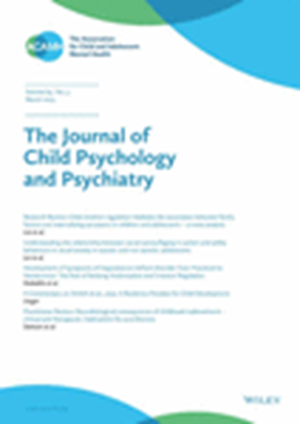Research Review: Sex differences in the clinical correlates of nonsuicidal self‐injury in adolescents – a systematic review
IF 6.5
1区 医学
Q1 PSYCHIATRY
引用次数: 0
Abstract
BackgroundNonsuicidal self‐injury (NSSI), or ‘the deliberate, self‐inflicted destruction of body tissue…without suicidal intent and for purposes not culturally sanctioned’, is a robust predictor of future suicide‐related behavior and therefore a modifiable target for suicide prevention. The prevalence of NSSI is rising in adolescents, particularly among females; however, it is unknown whether sex differences also exist in the clinical and psychosocial factors associated with NSSI. Understanding how the correlates of NSSI differ by sex is important for developing tailored treatments. This study systematically reviews sex differences in the clinical and psychosocial correlates of NSSI among adolescents.MethodsMEDLINE and PsycINFO were searched using the keywords ‘adolescents’, ‘self‐injury’, and ‘sex factors’ and synonyms for English‐language articles published between January 1, 2000 and May 10, 2022. We included studies that presented original data on NSSI, included adolescents ages 10–19, reported sex differences, and explicitly defined self‐injury as that done without suicidal intent. Fifty‐seven studies containing 54 unique samples were included. Data were summarized by sex and recorded by: (a) characteristics of NSSI, (b) clinical and psychosocial correlates of NSSI, and (c) associations with suicide.ResultsWe used data on NSSI from 54 unique samples of adolescents worldwide. Males more commonly used violent methods of NSSI, such as burning, and were more likely to be physically aggressive and experience substance abuse. Females more commonly self‐injured by cutting, and their NSSI was more likely to be repetitive and associated with emotional distress. In both sexes, NSSI was associated with adverse childhood experiences (ACEs) such as sexual abuse/violence and bullying. NSSI was predictive of suicide in females but not males.ConclusionsData from 22 countries and 352,516 participants suggest important sex differences in the clinical and psychosocial factors associated with NSSI among adolescents that future assessment and treatment strategies ought to consider.研究综述:青少年非自杀性自伤的临床相关因素的性别差异——一项系统综述
背景:非自杀性自伤(NSSI),或“故意的、自我造成的身体组织的破坏……没有自杀意图,出于非文化认可的目的”,是未来自杀相关行为的可靠预测指标,因此是自杀预防的可修改目标。青少年中自伤的发生率正在上升,尤其是在女性中;然而,与自伤相关的临床和社会心理因素是否也存在性别差异尚不清楚。了解自伤的相关因素如何因性别而异,对于制定针对性的治疗方法非常重要。本研究系统回顾了青少年自伤的临床和社会心理相关因素的性别差异。方法使用2000年1月1日至2022年5月10日期间发表的英文文章的关键词“青少年”、“自残”、“性别因素”和同义词对medline和PsycINFO进行检索。我们纳入了提供自伤原始数据的研究,包括10-19岁的青少年,报告了性别差异,并明确将自伤定义为没有自杀意图的行为。纳入了包含54个独特样本的57项研究。数据按性别汇总并记录:(a)自伤的特征,(b)自伤的临床和社会心理相关性,(c)与自杀的关联。结果我们使用了来自全球54个不同青少年样本的自伤数据。男性更常使用暴力的自伤方法,如燃烧,并且更有可能具有身体攻击性和药物滥用。女性更常通过割伤来自伤,她们的自伤更有可能是重复性的,并与情绪困扰有关。在两性中,自伤与不良童年经历(ace)有关,如性虐待/暴力和欺凌。自伤对女性自杀有预测作用,但对男性没有。结论来自22个国家和352516名参与者的数据表明,青少年自伤相关的临床和社会心理因素存在重要的性别差异,这是未来评估和治疗策略应该考虑的因素。
本文章由计算机程序翻译,如有差异,请以英文原文为准。
求助全文
约1分钟内获得全文
求助全文
来源期刊
CiteScore
13.80
自引率
5.30%
发文量
169
审稿时长
1 months
期刊介绍:
The Journal of Child Psychology and Psychiatry (JCPP) is a highly regarded international publication that focuses on the fields of child and adolescent psychology and psychiatry. It is recognized for publishing top-tier, clinically relevant research across various disciplines related to these areas. JCPP has a broad global readership and covers a diverse range of topics, including:
Epidemiology: Studies on the prevalence and distribution of mental health issues in children and adolescents.
Diagnosis: Research on the identification and classification of childhood disorders.
Treatments: Psychotherapeutic and psychopharmacological interventions for child and adolescent mental health.
Behavior and Cognition: Studies on the behavioral and cognitive aspects of childhood disorders.
Neuroscience and Neurobiology: Research on the neural and biological underpinnings of child mental health.
Genetics: Genetic factors contributing to the development of childhood disorders.
JCPP serves as a platform for integrating empirical research, clinical studies, and high-quality reviews from diverse perspectives, theoretical viewpoints, and disciplines. This interdisciplinary approach is a key feature of the journal, as it fosters a comprehensive understanding of child and adolescent mental health.
The Journal of Child Psychology and Psychiatry is published 12 times a year and is affiliated with the Association for Child and Adolescent Mental Health (ACAMH), which supports the journal's mission to advance knowledge and practice in the field of child and adolescent mental health.

 求助内容:
求助内容: 应助结果提醒方式:
应助结果提醒方式:


